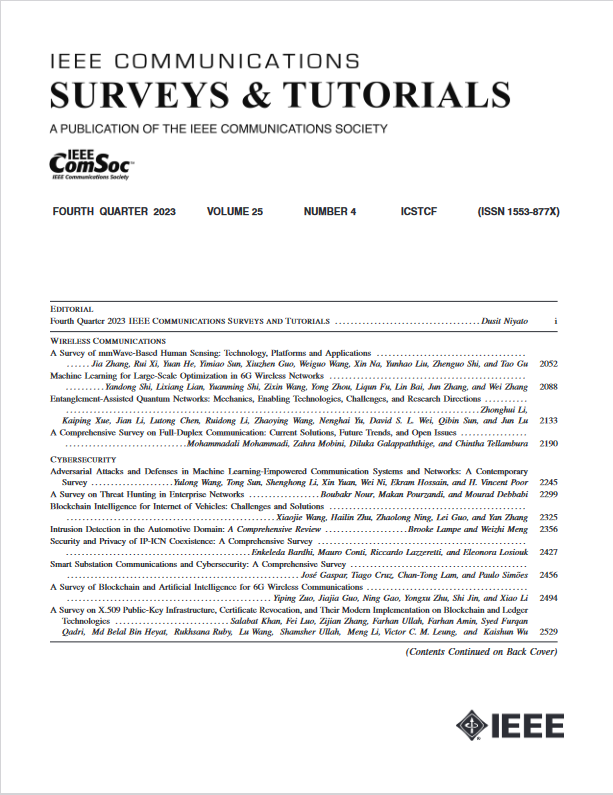A Comprehensive Survey on Optical Scattering Communications: Current Research, New Trends, and Future Vision
IF 34.4
1区 计算机科学
Q1 COMPUTER SCIENCE, INFORMATION SYSTEMS
引用次数: 0
Abstract
To meet high data rate requirements of future wireless communication systems, there is a need for advanced communication technologies that could be used in combination with existing wireless RF technologies. Recently, optical wireless communication (OWC) has been extensively investigated as an attractive alternate technology to RF. OWC uses the optical carrier to convey data, with wavelengths ranging from ultraviolet (UV) to infrared (IR) to visible light. In the past years, there is a spike in interest over optical scattering communications (OSCs) employing UV wavelengths, thanks to the recent advances and rapid developments in deep UV light-emitting diodes (LEDs), laser diodes, and solar-blind UV filters and detectors. The unique atmospheric scattering and absorption properties of the deep UV band, which is solar-blind at the ground level, are the motivation for the recent development of the OSC systems. However, there is a clear gap in the existing literature that the OSC systems are yet to be systematically surveyed for their applicability to future wireless communications. In this context, this paper bridges the gap by providing the first contemporary and comprehensive survey on recent and new advancements in the OSCs, commonly known as UV communications. In summary, this survey is expected to provide a largely missing articulation between various aspects of UV communications. To be easy to follow, we commence our discourse by surveying the propagation concepts and historic evolution of UV communication systems. Next, we provide a detailed survey on UV channel modeling because accurate channel characterization is important for efficient system design and performance optimization of UV communication systems. We discuss various UV channel characterization efforts thus far made. Then, we present a classification to analyze current OSC system designs. Importantly, we survey recent advancements in the NLOS UV communication systems that include the application of artificial intelligence, artificial neural networks, game theory, orbital angular momentum, etc. Moreover, we conduct a comprehensive survey on recently documented UV-based indoor communication systems. Finally, we point out several key issues yet to be addressed and collate potentially interesting and challenging topics for future research. This survey is aptly featured by in-depth discussion and analysis of UV communication systems in various aspects, many of which, to the best of authors’ knowledge, are the first time presented in this field.光散射通信综合调查:当前研究、新趋势和未来展望
为了满足未来无线通信系统的高数据传输速率要求,我们需要能够与现有无线射频技术相结合的先进通信技术。最近,人们对光无线通信(OWC)进行了广泛研究,认为它是射频技术的一种有吸引力的替代技术。光无线通信使用光载体传输数据,波长范围从紫外线(UV)到红外线(IR)再到可见光。近年来,由于深紫外发光二极管(LED)、激光二极管以及太阳盲紫外滤光片和探测器的最新进展和快速发展,人们对采用紫外波长的光散射通信(OSC)的兴趣骤增。深紫外波段具有独特的大气散射和吸收特性,在地面不受太阳光的影响,这也是近来开发 OSC 系统的动因。然而,在现有文献中还存在一个明显的空白,那就是尚未系统地研究 OSC 系统在未来无线通信中的适用性。在此背景下,本文首次对开放式调制解调器(俗称紫外通信)的最新进展进行了当代全面调查,从而弥补了这一空白。总之,本调查报告有望为紫外通信的各个方面提供基本缺失的衔接。为了便于理解,我们首先介绍了紫外通信系统的传播概念和历史演变。接下来,我们将详细介绍紫外信道建模,因为准确的信道表征对于紫外通信系统的高效系统设计和性能优化非常重要。我们讨论了迄今为止所做的各种紫外信道表征工作。然后,我们提出了一种分析当前 OSC 系统设计的分类方法。重要的是,我们考察了近来在非对称紫外通信系统方面取得的进展,包括人工智能、人工神经网络、博弈论、轨道角动量等的应用。此外,我们还对最近记录的基于紫外的室内通信系统进行了全面调查。最后,我们指出了几个有待解决的关键问题,并整理了未来研究中潜在的有趣和具有挑战性的课题。作者对紫外通信系统进行了多方面的深入探讨和分析,其中许多内容都是首次在这一领域提出。
本文章由计算机程序翻译,如有差异,请以英文原文为准。
求助全文
约1分钟内获得全文
求助全文
来源期刊

IEEE Communications Surveys and Tutorials
COMPUTER SCIENCE, INFORMATION SYSTEMS-TELECOMMUNICATIONS
CiteScore
80.20
自引率
2.50%
发文量
84
审稿时长
6 months
期刊介绍:
IEEE Communications Surveys & Tutorials is an online journal published by the IEEE Communications Society for tutorials and surveys covering all aspects of the communications field. Telecommunications technology is progressing at a rapid pace, and the IEEE Communications Society is committed to providing researchers and other professionals the information and tools to stay abreast. IEEE Communications Surveys and Tutorials focuses on integrating and adding understanding to the existing literature on communications, putting results in context. Whether searching for in-depth information about a familiar area or an introduction into a new area, IEEE Communications Surveys & Tutorials aims to be the premier source of peer-reviewed, comprehensive tutorials and surveys, and pointers to further sources. IEEE Communications Surveys & Tutorials publishes only articles exclusively written for IEEE Communications Surveys & Tutorials and go through a rigorous review process before their publication in the quarterly issues.
A tutorial article in the IEEE Communications Surveys & Tutorials should be designed to help the reader to become familiar with and learn something specific about a chosen topic. In contrast, the term survey, as applied here, is defined to mean a survey of the literature. A survey article in IEEE Communications Surveys & Tutorials should provide a comprehensive review of developments in a selected area, covering its development from its inception to its current state and beyond, and illustrating its development through liberal citations from the literature. Both tutorials and surveys should be tutorial in nature and should be written in a style comprehensible to readers outside the specialty of the article.
 求助内容:
求助内容: 应助结果提醒方式:
应助结果提醒方式:


